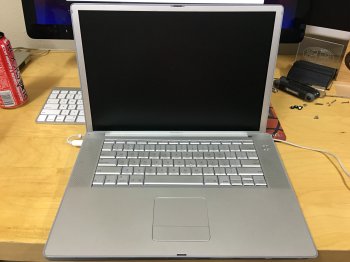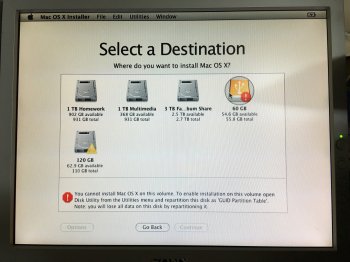Hello,
Longtime browser, first-time poster!
I have an ancient 15" PowerBook G4 that I recently put up for sale on Craigslist along with a few other old Macs in order to clear space at the office and just get rid of old stuff. The buyers took them off of my hands, and then tried reinstalling an OS on the PowerBook. They couldn't get it to go, which I thought was peculiar because the system was working when I gave it to them. I decided to be a nice guy and take the thing back and feed my tinkerer urge.
Now, I've performed dozens or hundreds of Mac OS X installs before, in all walks of Mac from early G3 machines to the most modern Xeon and i7. This one simply has me stumped. I fear it's something incredibly basic that I'm just missing. Let me try and break it down succinctly, although I sense that it will not end up being succinct...
OK, so first things first: I have a couple of known working hard drives. The issue is persistent on any hard drive I try. I have a couple of known working (and compatible) installation discs. The issue is persistent on any disc I try. I have the original, authentic media. I also have several installation ISOs on an external FireWire drive.
What happens when I attempt to install from optical drive is that the system gets to the white Apple logo screen with the pinwheel, but then all of a sudden the pinwheel stops and we go into freeze mode. There's no escaping this, and this exact thing occurs with any combination of hard drive and installation media.
When I try to install from an external FireWire drive, the boot selection screen does not have any options whatsoever — no external (or any) sources can be seen. My external FireWire drive is a LaCie and it has several compatible OS installers restored to it. Nary an option shows on the PowerBook G4 boot selection screen — and yes, I have 10.5 and 10.4 on there. I found it quite strange that these didn't appear.
I also tried booting and doing stuff in Target Disk mode. Absolutely zero luck there. Dead-end street to say the least with that one.
This is where it gets weird as heck.
Just for kicks and giggles, I removed the hard drive and then saw if the installation could get past the white Apple logo screen without the hard drive installed. Sure enough, it did! It rifled straight past that screen and into the traditional installation process screen with which we're all familiar. Problem: now there is no hard drive in the machine so I can't perform the install! I have tried installing the hard drive once we are in the installation mode, both inside the actual system and as an external USB drive. No luck there. Not really surprised by that, though.
I have reset the PRAM a number of times, left the machine unplugged and then plugged it back in, removed the removable battery; pretty much all the basic stuff that one does when a computer is acting up. I just can't figure this out.
My next guess is to completely replace the PRAM battery, as it's the original and therefore quite old.
At I type this post, I am currently performing an installation from one Mac (Mac Pro) to the hard drive I intend to use for the OS for the PowerBook G4. I'm doing the installation via standard installation but with the caveat that the target hard drive is actually connected to a USB/IDE adapter and the hard drive is not physically in the computer. The installation is going great and I've only got a few minutes to go. I have a bad feeling that when it is done, the PowerBook G4 still won't boot. Of course this is just a feeling so I won't know until I try it.
What's really weird is that when I break this all down, it seems like the inability to boot and perform an installation only occurs when there is a hard drive installed in the PowerBook G4. I simply do not understand that. The last time I used this computer, it was being used to drive a 30" aluminum Apple Cinema Display for a trade show, where it ran PowerPoints and other video to demonstrate product for our company. This was a few years ago, but the computer worked great at that time for this purpose — even though it was old then. I hadn't turned it on since then, though.
Any ideas?
Longtime browser, first-time poster!
I have an ancient 15" PowerBook G4 that I recently put up for sale on Craigslist along with a few other old Macs in order to clear space at the office and just get rid of old stuff. The buyers took them off of my hands, and then tried reinstalling an OS on the PowerBook. They couldn't get it to go, which I thought was peculiar because the system was working when I gave it to them. I decided to be a nice guy and take the thing back and feed my tinkerer urge.
Now, I've performed dozens or hundreds of Mac OS X installs before, in all walks of Mac from early G3 machines to the most modern Xeon and i7. This one simply has me stumped. I fear it's something incredibly basic that I'm just missing. Let me try and break it down succinctly, although I sense that it will not end up being succinct...
OK, so first things first: I have a couple of known working hard drives. The issue is persistent on any hard drive I try. I have a couple of known working (and compatible) installation discs. The issue is persistent on any disc I try. I have the original, authentic media. I also have several installation ISOs on an external FireWire drive.
What happens when I attempt to install from optical drive is that the system gets to the white Apple logo screen with the pinwheel, but then all of a sudden the pinwheel stops and we go into freeze mode. There's no escaping this, and this exact thing occurs with any combination of hard drive and installation media.
When I try to install from an external FireWire drive, the boot selection screen does not have any options whatsoever — no external (or any) sources can be seen. My external FireWire drive is a LaCie and it has several compatible OS installers restored to it. Nary an option shows on the PowerBook G4 boot selection screen — and yes, I have 10.5 and 10.4 on there. I found it quite strange that these didn't appear.
I also tried booting and doing stuff in Target Disk mode. Absolutely zero luck there. Dead-end street to say the least with that one.
This is where it gets weird as heck.
Just for kicks and giggles, I removed the hard drive and then saw if the installation could get past the white Apple logo screen without the hard drive installed. Sure enough, it did! It rifled straight past that screen and into the traditional installation process screen with which we're all familiar. Problem: now there is no hard drive in the machine so I can't perform the install! I have tried installing the hard drive once we are in the installation mode, both inside the actual system and as an external USB drive. No luck there. Not really surprised by that, though.
I have reset the PRAM a number of times, left the machine unplugged and then plugged it back in, removed the removable battery; pretty much all the basic stuff that one does when a computer is acting up. I just can't figure this out.
My next guess is to completely replace the PRAM battery, as it's the original and therefore quite old.
At I type this post, I am currently performing an installation from one Mac (Mac Pro) to the hard drive I intend to use for the OS for the PowerBook G4. I'm doing the installation via standard installation but with the caveat that the target hard drive is actually connected to a USB/IDE adapter and the hard drive is not physically in the computer. The installation is going great and I've only got a few minutes to go. I have a bad feeling that when it is done, the PowerBook G4 still won't boot. Of course this is just a feeling so I won't know until I try it.
What's really weird is that when I break this all down, it seems like the inability to boot and perform an installation only occurs when there is a hard drive installed in the PowerBook G4. I simply do not understand that. The last time I used this computer, it was being used to drive a 30" aluminum Apple Cinema Display for a trade show, where it ran PowerPoints and other video to demonstrate product for our company. This was a few years ago, but the computer worked great at that time for this purpose — even though it was old then. I hadn't turned it on since then, though.
Any ideas?



